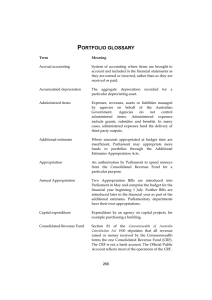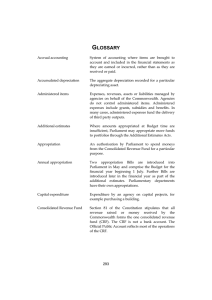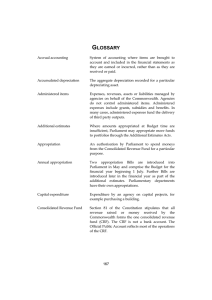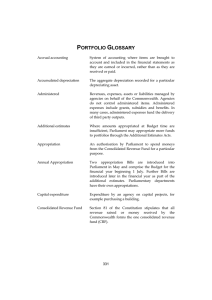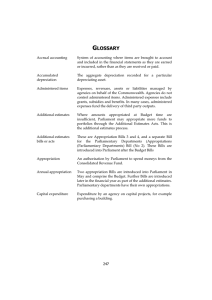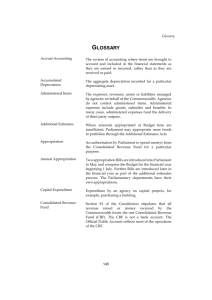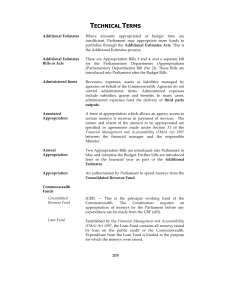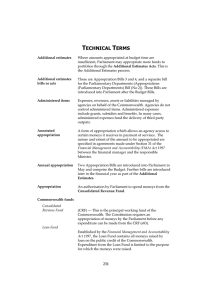P G ORTFOLIO
advertisement
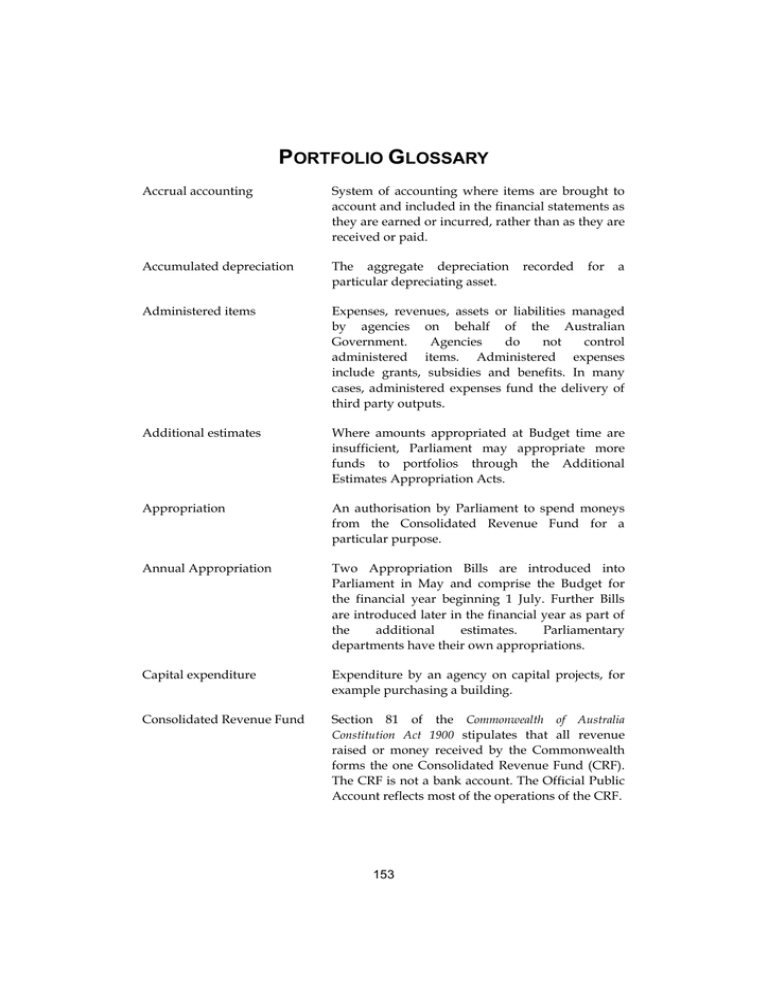
PORTFOLIO GLOSSARY Accrual accounting System of accounting where items are brought to account and included in the financial statements as they are earned or incurred, rather than as they are received or paid. Accumulated depreciation The aggregate depreciation particular depreciating asset. Administered items Expenses, revenues, assets or liabilities managed by agencies on behalf of the Australian Government. Agencies do not control administered items. Administered expenses include grants, subsidies and benefits. In many cases, administered expenses fund the delivery of third party outputs. Additional estimates Where amounts appropriated at Budget time are insufficient, Parliament may appropriate more funds to portfolios through the Additional Estimates Appropriation Acts. Appropriation An authorisation by Parliament to spend moneys from the Consolidated Revenue Fund for a particular purpose. Annual Appropriation Two Appropriation Bills are introduced into Parliament in May and comprise the Budget for the financial year beginning 1 July. Further Bills are introduced later in the financial year as part of the additional estimates. Parliamentary departments have their own appropriations. Capital expenditure Expenditure by an agency on capital projects, for example purchasing a building. Consolidated Revenue Fund Section 81 of the Commonwealth of Australia Constitution Act 1900 stipulates that all revenue raised or money received by the Commonwealth forms the one Consolidated Revenue Fund (CRF). The CRF is not a bank account. The Official Public Account reflects most of the operations of the CRF. 153 recorded for a Glossary Departmental items Assets, liabilities, income and expenses that are controlled by the agency in providing its outputs. Departmental items would generally include computers, plant and equipment assets used by agencies in providing goods and services and most employee expenses, supplier costs and other administrative expenses incurred. Depreciation Apportionment of an asset’s capital value as an expense over its estimated useful life to take account of normal usage, obsolescence, or the passage of time. Effectiveness indicators Measures the joint or independent contribution of outputs and administered items to the achievement of their specified outcome. Efficiency indicators Measures the adequacy of an agency’s management of its outputs (and where applicable, administered items). Includes price, quality and quantity indicators. The interrelationship between the three efficiency indicators of any one output should be considered when judging efficiency. Equity or net assets Residual interest in the assets of an entity after deduction of its liabilities. Expense Total value of all of the resources consumed in producing goods and services or the loss of future economic benefits in the form of reductions in assets or increases in liabilities of an entity. Fair value A valuation methodology whereby the amount for which an asset could be exchanged, or a liability settled, between knowledgeable and willing parties in an arm’s length transaction. The fair value can be affected by the conditions of the sale, market conditions and the intentions of the asset holder. 154 Glossary Operating result Equals income less expense. Outcomes The Government’s objectives in each portfolio area. Outcomes are desired results, impacts or consequences for the Australian community as influenced by the actions of the Australian Government. Actual outcomes are assessments of the end-results or impacts actually achieved. Output groups A logical aggregation of agency outputs, where useful, and based either on homogeneity, type of product, business line or beneficiary target group. Aggregation of outputs may also be needed for the provision of adequate information for performance monitoring, or based on a materiality test. Outputs The goods and services produced by agencies on behalf of government for external organisations or individuals. Outputs also include goods and services for other areas of government external to the agency. Price One of the three key efficiency indicators. The amount the government or the community pays for the delivery of agreed outputs. Quality One of the three key efficiency indicators. Relates to the characteristics by which customers or stakeholders judge an organisation, product or service. Assessment of quality involves use of information gathered from interested parties to identify differences between user’s expectations and experiences. Quantity One of the three key efficiency indicators. Examples include: the size of an output; count or volume measures; how many or how much. Revenue Total value of resources earned or received to cover the production of goods and services. 155 Glossary Special Account Balances existing within the Consolidated Revenue Fund (CRF) that are supported by standing appropriations (Financial Management and Accountability Act 1997 (FMA Act), subsection 20 and 21). Special accounts allow money in the CRF to be acknowledged as set-aside (hypothecated) for a particular purpose. Amounts credited to a Special Account may only be spent for the purposes of the Special Account. Special Accounts can only be established by a written determination of the Minister for Finance and Deregulation (section 20 FMA Act) or through an Act of Parliament (referred to in section 21 of the FMA Act). Special Appropriations (including Standing Appropriations) An amount of money appropriated by a particular Act of Parliament for a specific purpose and number of years. For special appropriations the authority to withdraw funds from the Consolidated Revenue Fund does not generally cease at the end of the financial year. Standing appropriations are a sub-category consisting of ongoing special appropriations — the amount appropriated will depend on circumstances specified in the legislation. 156
